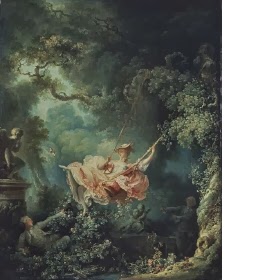Gwen 2- A Clone Drone.
For some brilliant
reason I woke one morning, leapt out of bed and encased Gwen in
layers of clingfilm, PVA soaked fabric and then paper – all before
breakfast.
Shame I can't remember
why it was so important to do, I hadn't planned it at all. The
process was fun enough and simple enough but had I thought about
drying time?
 Photo one is Tuesday. Photo 2 is Thursday. Still drying
on Saturday. I've taken the body cast off her and resealed it and
guess what? - waiting for it to dry. I've also made a paper cast of a
dinky body form to experiment with – it is still drying too. I have
headless bodies dotted round the house hogging the radiators.... why
does this make me want to put Christmas decorations up?
Photo one is Tuesday. Photo 2 is Thursday. Still drying
on Saturday. I've taken the body cast off her and resealed it and
guess what? - waiting for it to dry. I've also made a paper cast of a
dinky body form to experiment with – it is still drying too. I have
headless bodies dotted round the house hogging the radiators.... why
does this make me want to put Christmas decorations up?
 This brought nearly
everything to a halt- difficult to drape and fit without a model to
drape on and fit to. Never mind. It has been a finishing and
resolving week. The velvet purple spencer has been revamped, some
hems redone and illustrations, notes and pattern pieces put together.
Instead of total chaos taking over the house it is now organised
total chaos and coordinated heaps of things. Can't spot the
difference. I've roughed out a caraco to use up the scraps from the
blue rose fabric and hope to complete that this coming week once a
Gwen is free. The illustration below shows what it should be like (hope).
This brought nearly
everything to a halt- difficult to drape and fit without a model to
drape on and fit to. Never mind. It has been a finishing and
resolving week. The velvet purple spencer has been revamped, some
hems redone and illustrations, notes and pattern pieces put together.
Instead of total chaos taking over the house it is now organised
total chaos and coordinated heaps of things. Can't spot the
difference. I've roughed out a caraco to use up the scraps from the
blue rose fabric and hope to complete that this coming week once a
Gwen is free. The illustration below shows what it should be like (hope).
In the meantime it's
been research, paint and draw. I now know what Marie Antoinette wore
to the Revolution – fascinating book but still feeling rather
ambiguous about her ( felt sorrier for the husband!). The ideas of
clothing as a visible statement of status, personal attitudes and
political allegiance are still commonplace and mainstream, but it
was interesting. Still not sure whether it was the choice of clothing
or the attitudes leading to the choices that are important. She did
seem to give a lot of ammunition to her enemies with many of the
things she did.
Compared to the
current book this was light entertainment. Having read some of the
'Ackermann's Repository's on Google books (thank you for the free
downloads!!) I desperately need more background. I'm on page 12
(again) of a weighty tome– and there may stay – it's discussing
the underlying shifts in philosophy and attitudes that led to the Neo
Classical revival and Romanticism – apparently it wasn't just
finding Pompeii and all those Grand Tours. The posts on Google+ in
the Regency and general history communities are excellent at
providing snapshots of key people and places but stitching these
snippets into a broader understanding of the era is taking time.
 As light relief more
illustrations – new artists to trace down and try to remember, and
as usual the more I look the less it seems I know. I was brought up
with the formal portraits, but there are so many styles, some looking
back, some looking forward.
As light relief more
illustrations – new artists to trace down and try to remember, and
as usual the more I look the less it seems I know. I was brought up
with the formal portraits, but there are so many styles, some looking
back, some looking forward. While admiring the skill and drama of the formal, (Gainsborough's country house portraits of tall figures who tower above you in all of their finery, or of starchy court paintings,)
Of course there are
problems, dating the painting, attributing work – just take a look
at John Copley's listing on BBC paintings - some the handling is so
skilful and on others so clumsy. The same face reappears on different
bodies. Even within the one painting the quality can be radically
different. Some studios did have specialists to do various parts of a
painting such as the clothing ( my dream job, if anyone needs one
just ask!) or hands, and sometimes students filled in the unimportant
bits, but there should be a consistency of standard. Of course I
don't know which works were of a commercial standard and which may
have been rejected and stayed in the studio or reworked and sold on.
Some may have been retouched or repaired and this is not recorded on
most sources.
 Paul Sandby
Paul Sandby
Using portraits to
help with understanding the clothing isn't helped by the artists
having a stock of costumes which appear on a variety of patrons over
the years. A serious draw back as I've been using them to match hair
and accessories to dress styles as well as dress to artistic style!
Oops? But at least it makes it very clear where the traditions for the school photo poses come from!



No comments:
Post a Comment